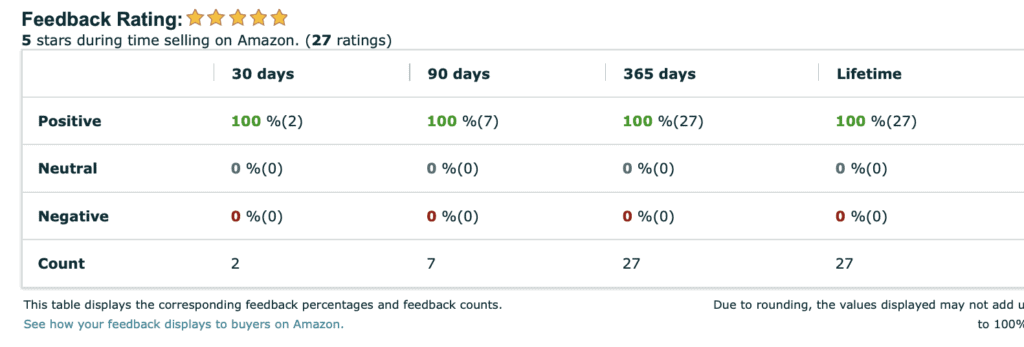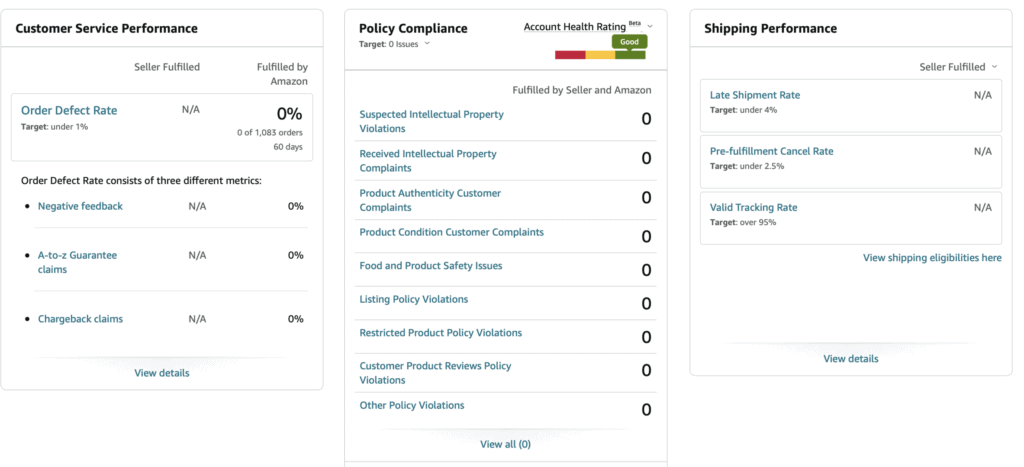Navigating the expansive world of Amazon can seem like a daunting task, especially when it comes to understanding and utilizing seller feedback effectively. Whether you’re an established eCommerce seller or an entrant cutting your entrepreneurial teeth on this revolutionary platform, excelling in Amazon seller feedback can be make-or-break. With this guide at your fingertips, we’ll deconstruct the enigma that is Amazon seller feedback, ensuring you have the knowledge to boost sales, build customer trust, and, more importantly, maximize profitability.
Introduction to Amazon seller feedback

Importance of seller feedback for Amazon sellers
Seller feedback refers to ratings and reviews left by customers on their overall experience with a particular retailer or vendor. Unlike product reviews, which target the item bought specifically, Amazon seller feedback focuses on transaction-specific details such as shipping speed, packaging quality, and service professionalism.
Your reputation as a vendor primarily stems from these nuggets of consumer insights. Effective management of your ‘seller ratings on Amazon’ can usher in far-reaching effects, including enhancing credibility among potential customers while bolstering visibility within the highly competitive marketplace through improved search rankings.
How Amazon seller feedback works
Understanding Amazon’s feedback system is important because it can greatly affect your store’s success. This system is based on a 5-star rating, covering everything from ordering to delivery and customer service.
After buying something, customers can rate sellers on things like how fast they ship and how well they handle service. These ratings help show the overall quality of shopping with that seller. Customers often write reviews, too, which helps others understand why a seller got a certain rating.
To see your feedback or someone else’s, go to any product you’re selling, click the link that says, “Sold by [seller],” then click “feedback”. You’ll see an overall star rating and recent comments by clicking the “See all customer feedback” tab.
These ratings are used by Amazon to decide who gets the ‘buy box’, a special spot on the product page. Since about 85% of Amazon sales happen here, having good feedback can really help your sales.
Tracking and analyzing your Amazon seller feedback

Navigating the eCommerce landscape, specifically on a highly competitive platform like Amazon, calls for strategic choices. A significant element that can transform your business trajectory is effectively tracking and analyzing your feedback, particularly your Amazon seller feedback.
Steps to find your Amazon seller feedback rating
Amazon has made it relatively simple to find your ‘seller feedback rating’. Here’s how you go about it:
- Begin by logging into your seller account on Amazon.
- Head towards the ‘performance’ menu; among the several options present, select ‘feedback.’
- This will lead you to your ‘feedback manager’ where you can view an overall score out of 5, calculated based on customer feedback Amazon has received regarding their experience with you as a seller.
Understanding the different metrics and scores in seller feedback
- Order defect rate (odr): this figure pertains to orders that have experienced one or more of these three issues: negative (one- or two-star) feedback, an a-to-z claim that wasn’t denied, or a credit card chargeback. Maintaining good standing with Amazon requires keeping your odr under 1%.
- Shipping time: an essential factor contributing to your overall performance metric is this score, which demonstrates if you’re shipping items promptly once an order is placed.
- Cancellation rate: orders cancelled by sellers before shipment for reasons excluding customer requests result in increased cancellation rates. High percentages are red flags for bad selling practices.
- Late shipment rate: as a critical part of selling on online platforms, ensuring timely fulfillment holds high significance; hence, orders shipped late get highlighted in this segment.
Continually tracking these scores allows you to improve your Amazon seller score, thereby increasing fulfillment efficiency and customer satisfaction. Moreover, tools like FeedbackExpress can automate this process, giving you more time to focus on other aspects of your Amazon business.

The benefits of positive Amazon seller feedback
Feedback is crucial in the world of online retail, and for a good reason. You may or may not know about some advantages that positive Amazon seller feedback harnesses for your business.
Building trust and credibility with customers
- Impact of Positive Feedback: Good customer feedback enhances your reputation as a reliable Amazon seller.
- Influence on Buyer Choice: Buyers often prefer sellers with positive reviews over those with negative feedback.
- Building Trust and Credibility: Excellent Amazon seller reviews foster customer trust and establish credibility.
- Long-Term Customer Relationships: Positive reviews contribute to lasting customer relationships and higher customer lifetime value.
Increasing sales and attracting more customers through positive feedback
Having enhanced trust and credibility from positive feedback on Amazon leads to tangible benefits in sales numbers. This creates a self-perpetuating cycle where better satisfaction leads to positive reviews, more sales, and even higher ratings. Happy customers frequently become repeat buyers and ambassadors, helping to grow your business organically.
Automating review requests after purchases can increase feedback from satisfied clients. Investing in exceptional service and product quality, as a seller, boosts customer satisfaction and increases sales, as positive reviews demonstrate your commitment to quality.
Strategies for getting good Amazon seller feedback

Providing excellent customer service
The phrase “the customer is always right” rings especially true within the eCommerce industry, where instant gratification through purchasing products and services is expected. But your duty as a seller doesn’t end once the product is dispatched; providing excellent post-sales service is key.
- Transparency: always maintain transparent communication with your customers regarding delivery timelines, product details, guarantees, or refunds.
- Swift response: be prompt in responding to queries or concerns, which reflects your attentiveness and proactively prevents the escalation of issues.
- Complimentary assistance: provide assistance even after completing sales transactions by addressing any potential setup issues or offering guidance on using the product effectively.
A takeaway here? High-quality interactions breed high-quality feedback for Amazon sellers.
Offering high-quality products and accurate product descriptions
There’s no substitute for quality when it comes to gaining customer approval and feedback on Amazon seller reviews. Selling top-notch goods ensures fewer returns and fewer negative comments, which invariably leads to encouraging reviews on Amazon.
Here’s how FeedbackExpress helps fulfill this:
- Our automated system facilitates receiving more positive testimonials without requiring an additional time investment.
- We provide a centralized platform that integrates customer retention efforts across various channels, thereby enhancing efficiency.
Promptly addressing customer concerns and resolving issues
Crucial steps to undertake are:
- Address problems swiftly: always address any complaints promptly, offering quick solutions.
- Customer empathy: show genuine empathy towards your customers’ experiences; personalizing responses and messages can portray this effectively.
- Follow-up actions: once an issue is closed, follow-up with the customer, ensuring their satisfaction and potentially asking for an amendment to their review if they hadn’t reviewed positively initially.
Following these tips in combination with using services like FeedbackExpress to automate review requests, you can improve your overall standing on Amazon seller ratings and aim toward becoming a top-tier invited merchant! Happy selling!
Dealing with negative or neutral Amazon seller feedback

The importance of addressing negative feedback promptly and professionally
As an Amazon seller, it’s crucial to address negative customer comments because they directly impact your brand’s image. Future buyers often rely on previous reviews, and a prevalence of negative feedback can deter them.
A study by Dimensional Research indicates that up to 90% of consumers are influenced by negative online reviews in their purchasing decisions. Ignoring unfavorable comments can reflect poorly on your responsiveness and commitment to customer satisfaction.
Addressing criticism quickly and thoughtfully helps preserve customer relationships and enhances brand loyalty among both existing and potential clients.
Steps to effectively respond to negative or neutral feedback on Amazon
Below are four concrete steps illustrating how an Amazon seller can turn the tide favorably:
- Collocate your responses: use Amazon’s central ‘feedback manager’ tool for gathering all your seller ratings on Amazon and pinpointing areas warranting improvement.
- Analyze the root cause: do not rush when responding out of frustration; instead, take time to understand the buyer’s perspective genuinely.
- Respond diplomatically: draw up a sincere apology for any dissatisfaction caused, then articulate how you plan to rectify this issue swiftly.
- Follow up regularly: this signifies to customers that you’re dedicated to ensuring they have an entirely satisfactory shopping experience, even if things went south initially.
- Automate Feedback: Leverage software like FeedbackExpress to automate feedback requests but also to monitor, analyze, and respond to negative reviews.
Remember that every interaction with a customer shapes their perception of your brand. Dealing with negative feedback as an Amazon seller might seem daunting at first, but managing this professionally represents an opportunity to display your commitment to top-notch customer service.
So next time you spot a half-hearted seller response, remember that a proper response has the power to restore faith in unsatisfied customers. This advice is central to fostering trust among customers, both existing and prospective.
Removing seller feedback on Amazon

Circumstances where you can request removal of specific feedbacks
The criteria for considering feedback removal by Amazon are as follows.
- Offensive language: if a review contains obscenities or spiteful remarks vilifying either the seller or Amazon.
- Personal information: according to Amazon’s privacy policy, sharing personal information (contact details, real names) is forbidden in reviews.
- Product reviews: sometimes buyers mistake seller feedback for product reviews—a common error that leads to misdirected criticism.
- Fulfillment experiences for fba orders: as an Amazon seller using fulfillment by Amazon (fba), it’s crucial to remember that any shipping-related complaints aren’t your fault and should not be reflected in your seller ratings.
Keep these in mind when requesting feedback removal because having these as grounds for removal strengthens your case significantly with customer service at Amazon.
How to request removal of seller feedback on Amazon

Once you have identified problematic feedback fitting the aforementioned scenarios, here’s how you go about its removal:
- Start by going to the ‘feedback manager,’ located within your seller central account. Find the tricky piece under “recent feedback” and hit “request removal”, If it doesn’t meet the automatic removal criteria set by Amazon feedback service rules, click “contact us” instead.
- Proceed by selecting ‘selling on Amazon,’ followed by ‘customers and orders.’ Here you’ll need to fill out the order ID related to said review along with your corresponding comments explaining why this particular comment should be considered for deletion.
- Feedback removal requests tend to be successful only when they are unjust or against the feedback policy, so always ensure you have a well-grounded reason before proceeding.
Remember—an online marketplace works both ways: just as the customer feedback Amazon sellers receive can sway potential buyers, your commitment to providing excellent service will not go unnoticed. So even if you navigate through some rough waters occasionally, keep sailing!


